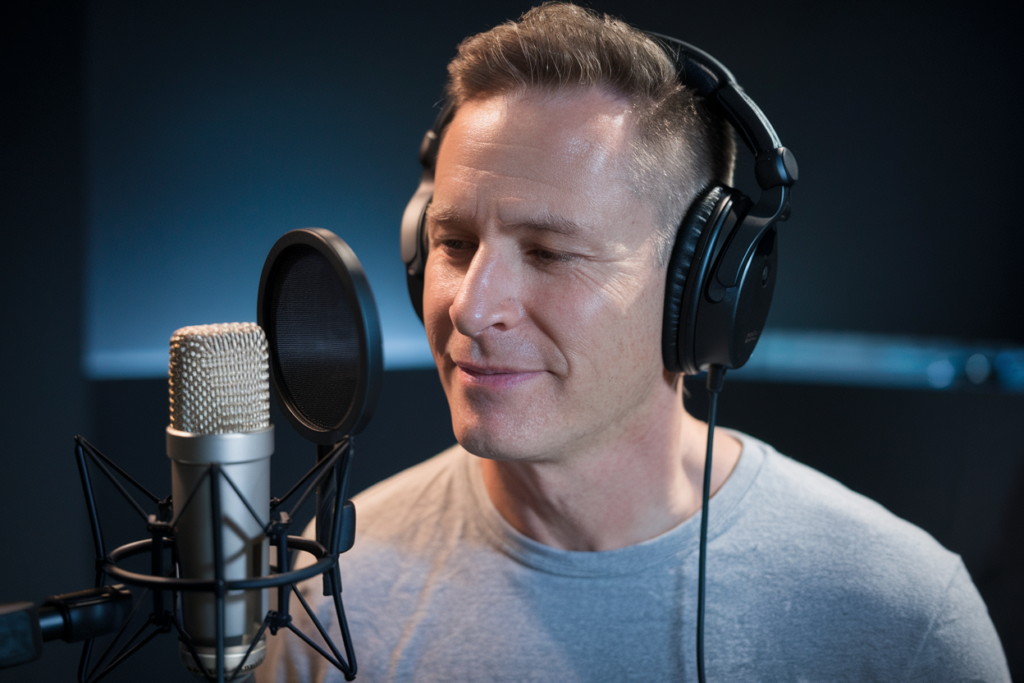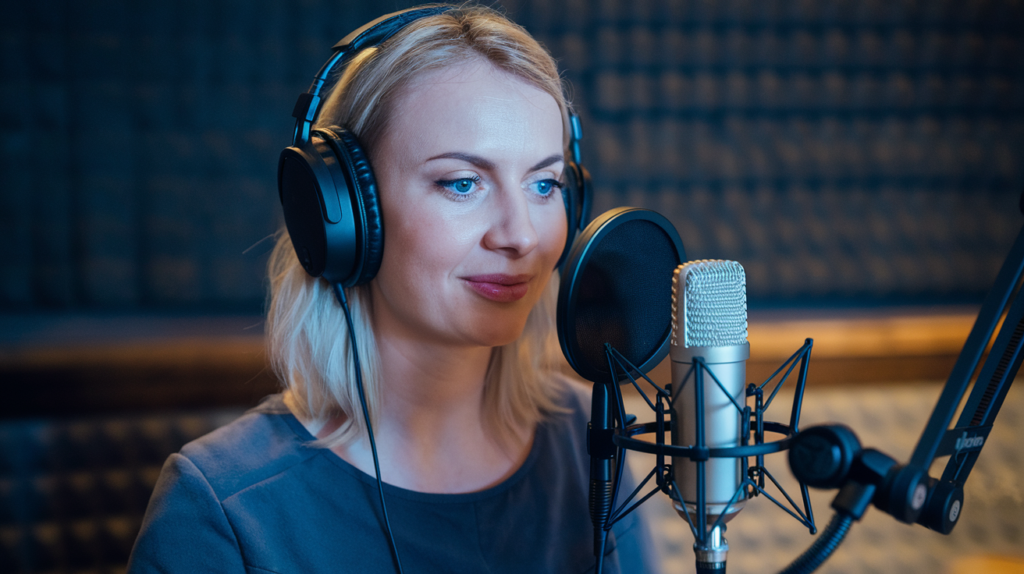Key Takeaways
- Character Analysis: Understanding character backgrounds and motivations is vital for voice actors to deliver authentic performances that resonate with audiences.
- Vocal Warm-Ups: Implementing vocal exercises before recording helps actors prepare their voices, enhancing clarity and preventing strain during long sessions.
- Real-Time Feedback: Providing constructive feedback during recordings allows voice actors to adjust their performances on the spot, ensuring alignment with the project’s vision.
- Improvisation Techniques: Encouraging improvisation can unlock creativity in voice artists, allowing them to explore different interpretations of their characters without fear of judgment.
- Collaborative Environment: Establishing trust among team members fosters open communication, leading to innovative ideas and richer performances in voice acting projects.
Have you ever wondered what sets apart a great performance from a mediocre one in Polish voice acting? The answer often lies in the direction techniques used by talented directors. Mastering these methods can elevate not just the actor’s performance but also the entire project.
Overview of Polish Voice Actor Direction Techniques
Polish voice actor direction techniques play a crucial role in shaping the quality of voiceovers. These methods enhance the performance of voice actors, ensuring they deliver emotive and engaging performances that resonate with audiences.
One effective technique is character analysis. Directors often guide voice actors through character backgrounds, motivations, and relationships. Understanding these elements allows actors to bring depth and authenticity to their roles. For instance, when portraying a young hero or an elderly sage, nuances in delivery can significantly influence audience perception.
Another important method involves vocal warm-ups. Before recording sessions, directors encourage voice talent to participate in vocal exercises. Warm-ups prepare the actor’s voice for various emotional ranges and pitches. This practice enhances clarity and prevents strain during long recording hours.
Feedback loops are also vital in directing Polish voice actors. Directors provide real-time feedback during recording sessions, helping artists adjust their performances on the spot. Constructive feedback fosters growth and ensures that each take aligns with the project’s vision.
Additionally, employing improvisation exercises can unlock creativity within a session. When directors incorporate moments for spontaneity, it enables voice artists to explore different interpretations of their characters without fear of judgment.
Lastly, establishing a strong collaborative environment is essential. A director who creates trust encourages openness among team members—both voice talents and production staff—leading to innovative ideas and richer performances.
By mastering these techniques, you ensure your projects achieve high-quality results that captivate listeners across various platforms.
Key Elements of Voice Acting Direction
Voice acting direction plays a crucial role in shaping the performance of voice actors. Understanding these core elements can elevate any project, ensuring that your voiceovers resonate with audiences.
Understanding the Character
Understanding the character is essential for delivering authentic performances. As a director, you guide voice artists through detailed character analyses. Discussing backgrounds and motivations allows them to grasp who they’re portraying fully. Encourage actors to ask questions about their roles and provide insights into the character’s emotional state or goals. This depth will translate into more engaging and believable voiceovers, making your project stand out.
Emotional Guidance
Emotional guidance helps actors connect with their characters on a deeper level. You can create an atmosphere where emotions flow freely by providing clear direction on tone and intent. Use specific language when discussing emotional beats; instead of saying “be sad,” describe how that sadness might sound or feel within the context of the scene. This approach makes it easier for voice talent to tap into their feelings and convey genuine emotion through their performances, enhancing overall impact in each recording session.
Techniques Used by Experienced Directors
Experienced directors utilize specific techniques that enhance voice acting performances, ensuring voice artists deliver captivating and authentic voiceovers. Mastering these methods can lead to outstanding results that resonate with audiences.
The Role of Auditions
Auditions serve as a vital step in the casting process for voice actors. They allow directors to assess not only the technical skills of the talent but also their ability to embody characters. During auditions, directors often provide direction on emotional tone and delivery style, which helps evaluate how adaptable the actor is. This interaction lays the foundation for collaboration and sets expectations for future sessions.
Directors may also encourage improvisation during auditions, allowing voice artists to showcase creativity and unique interpretations of characters. This exploration can reveal hidden strengths or styles that align perfectly with project needs.
Feedback Methods
Feedback plays a crucial role in refining performances from voice actors. Experienced directors establish clear communication channels during recording sessions, ensuring feedback is constructive and timely. Real-time feedback helps artists adjust their deliveries immediately, enhancing overall performance quality.
Directors often use specific language when providing critiques or suggestions, focusing on emotional beats or vocal nuances rather than vague statements. For instance, saying “try it with more warmth” offers clearer guidance than simply stating “make it better.”
Creating an open atmosphere encourages dialogue between you and the director. When you feel comfortable asking questions or seeking clarification, it leads to richer performances that truly capture the essence of your character.
By employing these techniques—focusing on auditions and effective feedback—directors ensure that every session maximizes potential growth while delivering high-quality voiceovers tailored to audience expectations.
Challenges Faced in Voice Acting Direction
Voice acting direction presents unique challenges that can impact the quality of voiceovers. Understanding these hurdles helps enhance the overall production process.
Communication Gaps
Communication gaps between directors and voice actors often lead to misunderstandings. When a director’s vision isn’t clearly conveyed, it results in performances that miss the mark. Clear instructions, along with specific examples, can bridge this gap and ensure everyone is on the same page.
Emotional Interpretation
Another challenge lies in emotional interpretation. Different voice artists bring varied backgrounds and experiences to their roles, which may affect how they perceive emotions. Directors need to guide voice actors through emotional nuances while allowing room for personal expression.
Technical Limitations
Technical limitations also pose challenges during recording sessions. Equipment failures or subpar studio conditions can hinder performance quality. Ensuring top-notch equipment and a comfortable environment allows actors to focus solely on delivering their best work.
Balancing Creativity and Direction
Striking a balance between creativity and direction can be tricky. While you want your voice talent to explore creative avenues, too much freedom might stray from the intended vision. Establishing boundaries while encouraging exploration fosters an atmosphere where innovation thrives without compromising project goals.
Time Constraints
Time constraints frequently pressure both directors and voice artists during recordings. Rushed sessions often lead to suboptimal performances or incomplete takes, impacting final output quality. Planning sessions with ample time for adjustments ensures thorough exploration of character depth and performance refinement.
Cultural Differences
Cultural differences among international teams can complicate interpretations of tone, humor, or context within scripts. Navigating these variations requires sensitivity from directors alongside open dialogue with their voice over talent to achieve authentic portrayals that resonate globally.
Addressing these challenges directly enhances not only actor performances but also enriches the overall production experience for everyone involved in creating captivating voiceovers.
Conclusion
Implementing effective voice actor direction techniques is crucial for achieving standout performances in Polish voice acting. By prioritizing character analysis and creating a supportive environment, you can elevate the quality of your projects.
Incorporating vocal warm-ups and real-time feedback fosters growth and enhances emotional authenticity. Embracing improvisation unleashes creativity while establishing open communication helps bridge any gaps between directors and actors.
Understanding the challenges faced during production allows you to navigate obstacles effectively. By applying these strategies, you’ll not only boost individual performances but also enrich the overall experience for everyone involved in crafting compelling voiceovers.
Frequently Asked Questions
What are the key factors that differentiate great voice acting performances?
Great voice acting performances stand out due to effective direction techniques, character analysis, vocal warm-ups, and real-time feedback. Directors play a crucial role in guiding actors to understand their characters deeply, fostering creativity through improvisation while maintaining clear communication throughout the recording process.
Why is character analysis important in voice acting?
Character analysis helps actors grasp their roles’ backgrounds and motivations, enabling them to deliver authentic performances. By understanding a character’s emotional state and goals, actors can portray depth and nuance that resonates with audiences.
How do vocal warm-ups benefit voice actors?
Vocal warm-ups prepare an actor’s voice for varying emotional ranges and help prevent strain. These exercises enhance vocal flexibility and control, ensuring performers can express emotions effectively during recordings.
What role does feedback play in improving performances?
Feedback is essential for refining performances as it allows directors to communicate specific guidance during sessions. Constructive feedback fosters an open atmosphere where actors can adjust their delivery based on real-time insights, leading to richer interpretations.
How do improvisation exercises contribute to voice acting?
Improvisation exercises unlock creativity by allowing voice artists to explore different interpretations of their characters. This practice encourages spontaneity and innovation, resulting in more engaging and unique voiceovers that capture audience attention.
What challenges do directors face when directing voice actors?
Directors often encounter challenges such as communication gaps with actors, varied emotional interpretations, technical limitations like equipment issues, time constraints, and cultural differences within international teams. Addressing these hurdles is vital for achieving high-quality performances.
How can trust among team members enhance performance quality?
Establishing a strong collaborative environment fosters trust among team members. When directors create an open space for dialogue and idea sharing, it leads to innovative approaches that enrich both the creative process and the final performance outcome.







